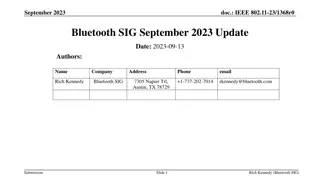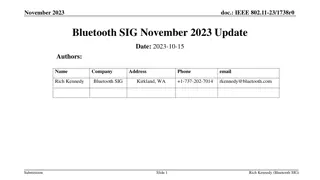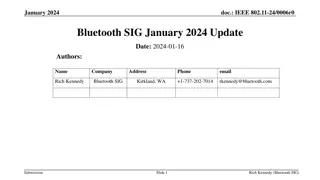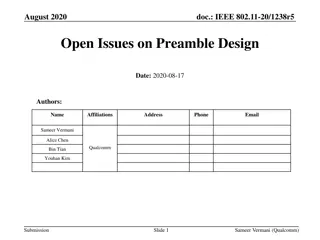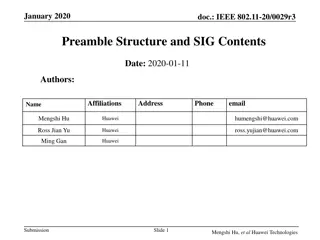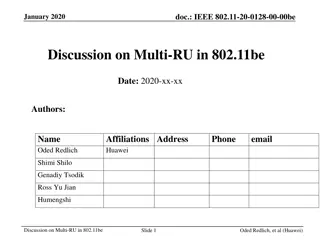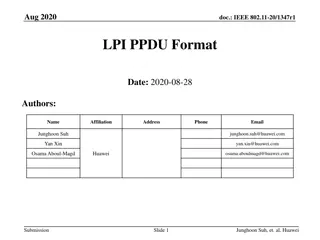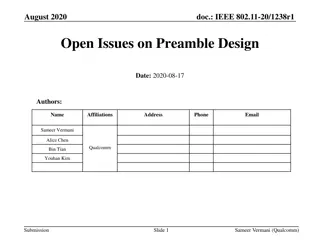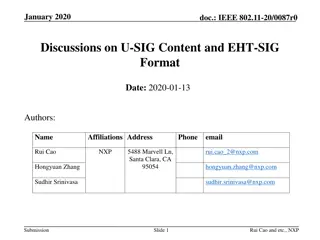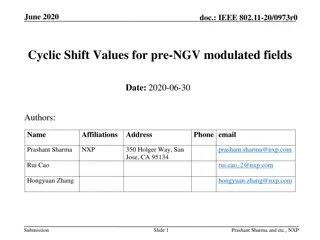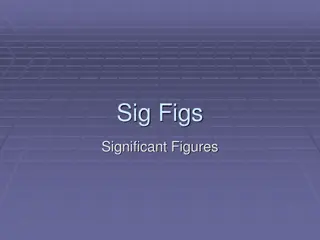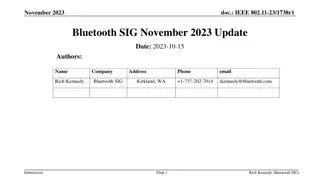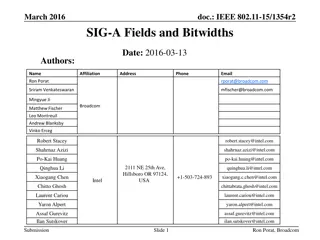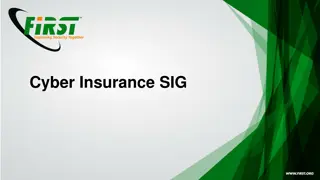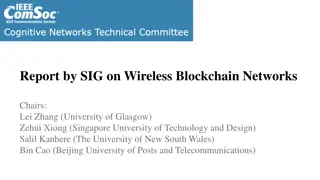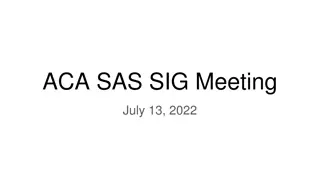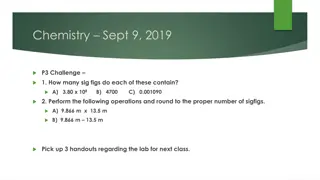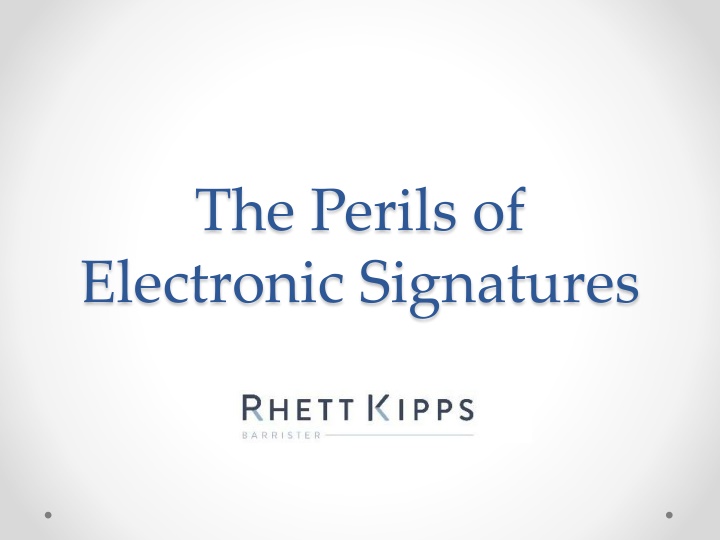
Electronic Signatures in Contract Law
Explore the intricacies of electronic signatures in the context of contract law, covering topics such as authentication, the importance of signatures in written agreements, and the comparison of electronic and physical signatures for validity.
Download Presentation

Please find below an Image/Link to download the presentation.
The content on the website is provided AS IS for your information and personal use only. It may not be sold, licensed, or shared on other websites without obtaining consent from the author. If you encounter any issues during the download, it is possible that the publisher has removed the file from their server.
You are allowed to download the files provided on this website for personal or commercial use, subject to the condition that they are used lawfully. All files are the property of their respective owners.
The content on the website is provided AS IS for your information and personal use only. It may not be sold, licensed, or shared on other websites without obtaining consent from the author.
E N D
Presentation Transcript
The Perils of Electronic Signatures
Summary Contract Law Signatures & Electronic signatures Authentication of signatures Problems with electronic signatures Mitigating risks with electronic signatures
Contract Law Written contracts Terms construed generally within the four corners of the document Acceptance Signed by all parties in writing Conduct Oral acceptance What happens when the signature is electronic?
Signatures A signature does not require physical pen to paper, but can be accomplished by mechanical means; is to authenticate the genuineness of a document; and requires the signer to put his or her mind to it. R v Moore; Ex parte Myers [1884] 10 VLAR 322, 324
Importance of signatures and written agreements Commercial arrangements require certainty Simple/convenient way to show that a party has accepted terms The law prescribes certain documents to be in writing Property Law Act 1974 (Qld), s 56(1) guarantee must be in writing in order to be enforceable Property Law Act 1974 (Qld), s 59 contract for sale of land must be in writing in order to be enforceable
Authentication - physical signatures Physical wet signatures can be compared against known genuine signatures by a forensic document expert That expert can then use that comparison to express an opinion about whether the same person applied both signatures But what about electronic signatures?
What is an electronic signature? A cryptographic signature
What is an electronic signature? Email footer/signature
What is an electronic signature? A scan of a physical wet signature
Electronic Transactions Act Electronic Transactions Acts All states and Commonwealth A transaction (including a contract ) is not invalid merely because it took place by one or more electronic communications There are exceptions, e.g. Corporations Act 2001 (Cth)
Electronic Transactions Act S.14 Qld ETA Requirement for signature taken to be met if: The method used to identify the person and that person s intention Method used is: as reliable as appropriate; or otherwise proven to be identified and intention proven
Electronic Transactions Act I.e. if you want to rely upon electronic signatures, take care
Examples McGuren v Simpson [2004] NSWSC 35 an email with the person s name appearing in the from field held to be signed for the purposes of s 54 of the Limitation Act 1969 (NSW) eBay International AG v Creative Festival Entertainment Pty Ltd [2006] FCA 1768 the act of clicking a button accepting terms and conditions appearing on a website constituted signing a contract in writing Islamic Council of South Australia v Australian Federation of Islamic Councils Inc [2009] NSWSC 211 in obiter, typewritten name may be sufficient Kavia Holdings Pty Ltd v Suntrack Holdings Pty Ltd [2011] NSWSC 716 inclusion of sender s name on an email is a signature for the purposes of signing an option to renew a lease Kation Pty Ltd v Lamru Pty Ltd [2012] NSWSC 356 names appearing in heads to columns setting out amounts payable were not signatures
Electronic Signature Systems Online web site controlled by username and password User registers; uploads image of signature; uploads documents to sign ; applies image to document; and document is therefore signed PDF scan of signed document can be downloaded and emailed to party placing reliance upon document
Authentication What if the signatory later alleges signatures not theirs? Signature applied by system without authority Someone may have accessed their account without authority and applied their signature to the document Analogous to a forgery But forensicdocument expert is no assistance What about enquiries of electronic signature provider?
Practical issues Likely a foreign (US) provider How does the system work now and how did it work back then? Representations about how system worked is hearsay - inadmissible First hand evidence from provider about how it worked? Leave for International Subpoenas? Letters Rogatory Process? Foreign law may preclude assistance unless foreign court requires production Might ultimately get an IP address and some information about how the user was authenticated (i.e. email/username/password) Significant delay and cost to adducing evidence
Workarounds Witnesses to signatures Acceptance of contract by other means i.e. conduct Ratification Agency / Estoppel
Ratification Person must have knowledge of the material terms of the contract before they can ratify it There exists a further question as to whether or not a forgery can be ratified Rowe v B&R Nominees Pty Ltd [1964] VicRp 59
Ostensible Agency and Estoppel Necessary to establish that the principal/signatory had put in place some sort of organisational structure to give the appearance that others had authority to bind him/her Representation from the principal
Personal Guarantees But what if the signature is a personal guarantee? Very hard to prove ratification or acceptance by conduct unlikely to have any conduct of the guarantor to rely upon Agency difficult for individual guarantors as no organizational structure
Case study Facts Supplier receives standard credit application from customer Apparently executed by company and its director guarantors, and witnessed Trade on account successfully for years Customer fails to make payment Creditor institutes recovery proceedings against guarantors One guarantor alleges that he did not sign the guarantee, and that his electronic signature was applied to the document by a third party without his knowledge or authority
Case study Facts Online signature system Email address & password List of documents on login Out for Signature , Signed Account used by guarantor after document Signed
Case study (cont.) Issues How did the system work then and now? Admissible evidence of system? Did the guarantor know of the application, and the guarantee? Had subsequent trade been ratified? What about continued use of the electronic signature system?
Case study (cont.) Guarantor's credit accepted did not know of signature Knowledge of the credit application itself not enough Evidence of how system worked years ago was difficult to adduce Ratification required creditor to prove that: System showed list of documents on each subsequent login Guarantor downloaded the particular signed document Guarantor appreciated that the document signed included a personal guarantee No representation from guarantor sufficient to found estoppel
Case study (cont.) The electronic signature was unenforceable to bind guarantor Similar effect as if it was a forgery Williams Group Australia v Crocker [2015] NSWSC 1907 Williams Group Australia v Crocker [2016] NSWSCA 265
Mitigating the risks A signature alone is not sufficient to identify a signatory s acceptance Forgery risk applies to electronic documents Build up evidence which may support alternative acceptance/ratification I.e. check details, call person, SMS, post, etc. Document the steps taken at the time; those steps may be critical years later Verification by witness; ensure sufficient evidence of it will be available years later if evidence required
T E A W 0408 011 019 or 07 3210 2233 rhett@rhettkipps.com Level 12, 239 George Street, Brisbane, Q 4000 www.rhettkipps.com Liability limited by a scheme approved under Professional Standards Legislation


